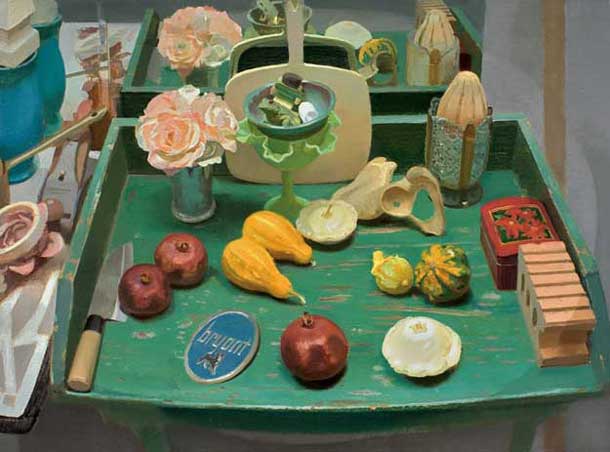
Scott Noel, Enceinte, oil on linen, 34 x 46 inches courtesy of the Gross Mccleaf Gallery
Scott Noel: A Life in Paint
By Elana Hagler
(Guest Writer for Painting Perceptions)
As I enter through the door in the side of the large industrial building in Manayunk, a slightly run-down but vigorous town of blockish looking rowhouses inside Philadelphia, I emerge into the convoluted series of hallways lined with artists’ studios, and I immediately feel lost. Even though I have been here before, I stand still for a dizzy moment, trying to figure out which way to go. And then, inevitably, Scott Noel’s ever enthusiastic voice rings out from somewhere within this maze, followed by the murmured reply of a conversation partner, and I follow it like a beacon. As I step into Scott’s studio, the familiar, intoxicating scent of oil paint gets stronger and I am hit on all sides by vibrating, sensuous color…I am Dorothy suddenly transported into a delightfully painterly Oz. And there stands the Wizard. But this Wizard is not some larger-than-life phantasm that turns out to disappoint. In front of me stands a slight, wiry man with an unassuming aspect and a wry and biting sense of humor that covers an incredibly probing mind and a generous heart. Scott Noel is one of the very few living painters I go to in order to recharge. Visiting his studio, one becomes more certain of the profound, meaningful seriousness of the artistic endeavor, and of the sheer joy of the struggle.
The walls of his studio are covered, salon-style, with his most recent paintings and drawings. There are large, multi-figure compositions in oil on lead-primed, rabbit-skin glued linen, hanging alongside lushly painted still-lifes wherein humble plastic knickknacks democratically share the space with vases, art objects and no-longer edible edibles. Another wall is plastered with pastel figure drawings which Scott creates alongside his students in class and uses as teaching tools. His paintings often contain allegorical allusions, and reference history, mythology and literature, but yet remain very much models in a studio or the objects of daily life plunked down seeming haphazardly on the studio table. During a slide show of his work, Scott once mentioned that as he works on a painting, he finds that he starts to tell stories to himself, but that the inspiration for the start of a painting is always a visual, formal investigation.
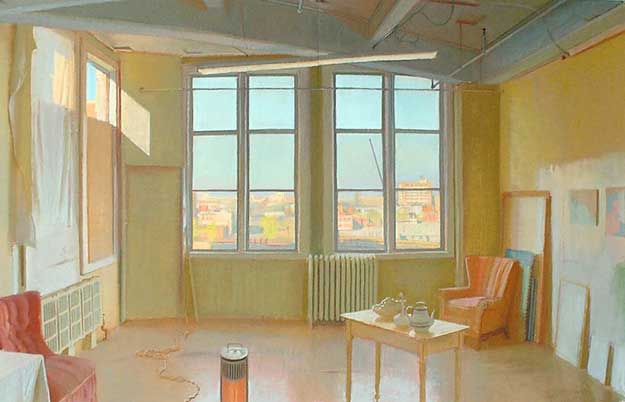
Studying the Studio pastel 40 x 64 inches 2010
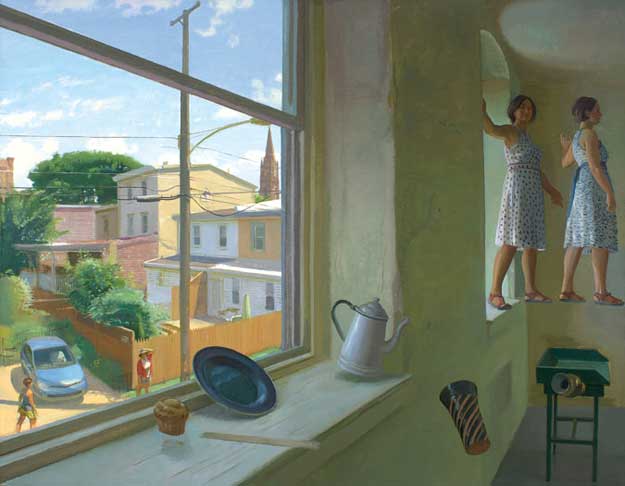
Advent of the Muses, oil on linen, 56 x 72 inches

Orpheus and Eurydice linen 54 x 50 inches 2008
I have had the good fortune of being a student of Scott’s at the Pennsylvania Academy of the Fine Arts, as well as a teaching assistant for a painting course and a friend of many years. So I feel that I can speak to both his artwork and his role as a teacher. I have seen the great effect which he has had on so many young painters, many of whom have already become admirable artists and instructors in their own right. Scott is incredibly giving with his knowledge and always encouraging to young painters. More than that, he is a model of a life lived in the commitment to the perceptual moment.
Scott paints alla prima (Italian for “at once”), a very direct approach to painting where patches of opaque color are worked wet-into-wet, rather than the slow build-up of glazes over an underpainting, with the goal of a unified, fresh-looking surface and the ability to start and complete large chunks of the painting at one long sitting. If a day’s work fails to come together at the end of the sitting, Scott scrapes the whole wet area down with his pallet knife, leaving a ghostly image underneath which serves as the platform for entry for the next day’s work. He always paints directly from life, as he believes that photography does not give enough information to be able to grasp the kind of (in his words) “equivalence for movement, weight, and the interdependence of volume and space” which he is after.
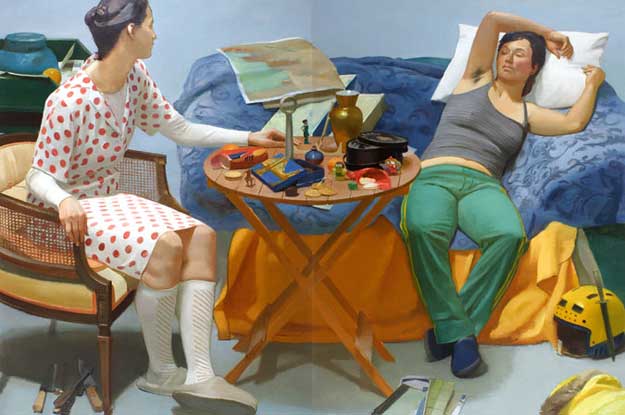
Octavia and Antonia Divide the Empire, oil on linen (two panels), 72 x 108 inches
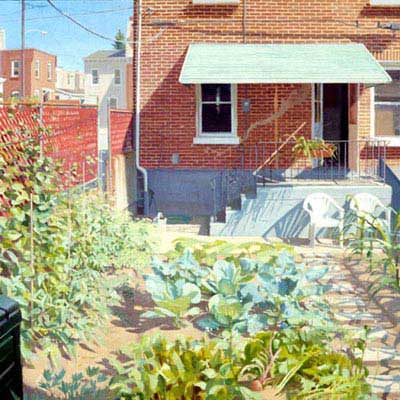
Jan’s Garden, oil on canvas, 59 x 59 inches
Both in his teaching and in his own work, Scott attempts to negotiate a meeting point between two very different approaches to art-making. First, there is the color spot tradition passed down from Charles Hawthorne and his student Edwin Dickinson, which is the prevalent attitude espoused by many top-notch realist painters today. This approach emphasizes the direct laying down of large, flat spots of color with very specifically modulated relationships to one another, where the fine-tuning of color, tone and edge create space, rather than the outlining of objects that are then described with a chiaroscuro approach. Scott integrates this approach, most especially in his drawings, with a more sculptural rendering of space, looking back to artists such as Michelangelo and Pontormo, where he “de-emphasize(s) contour and light in favor of gesture, mass, cross-contour and changes of state in a graphic investigation.” All the while, he constantly stresses composition, with the placement of everything within the rectangle being of incredible importance. Rather than aiming for the maximum contrast of light and dark, Scott keeps his overall tonality in the middle range, which evokes a twilight world of intense and closely modulated color relationships. At the same time, it is the hunger for the experience in the prolonged moment of painting and responding to the motif, the frantic attempt to grasp and organize all those sensations which are occurring and changing all at once and have to be concretized while the paint is wet, that keeps him addicted. All this is brought together in very fluid and dynamic tensions, which invigorate his paintings and open up the space for a deeper, more intuitive experience of viewing his work.
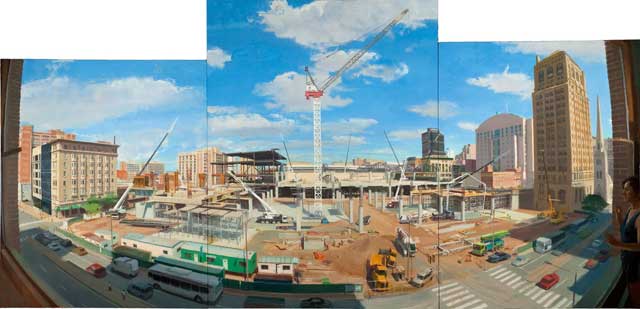
Expanding the Convention Center, oil on linen (three panels), 72 x 148 inches
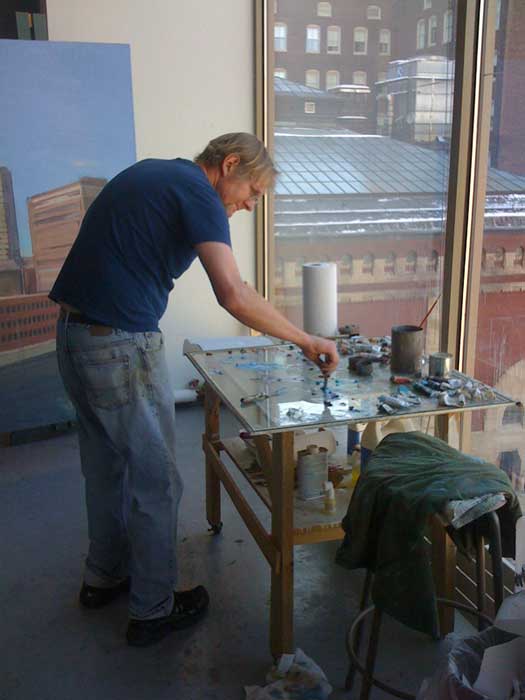
Scott Noel painting, Photo by Mike Manley ( many great photos, artwork and information about Scott Noel on his blog – Drawman.blogspot.com )
Scott Noel is one of the few painters who is not only able to masterfully embody these various struggles and aims in his work but is also able to articulate them in such a way that not only makes them understandable but also seductive to the young painter. Scott always encouraged in me a love for the wholeness of perception, I would even say the wholeness of existence, accepting even that which is problematic, in the world and in myself, and integrating it and shaping it to try to produce an artwork which is so much more than a mimetic image, but under the best of circumstances becomes a fictionalized embodiment of reality that embraces a more complicated beauty and somehow, deep inside, rings true.
ArtPneuma YouTube video of Scott Noel discussing his painting:
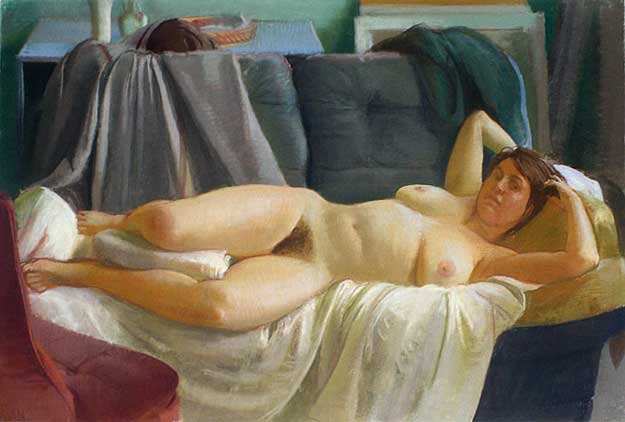
Reclining Portrait of Vivian pastel 30 x 44 inches 2010
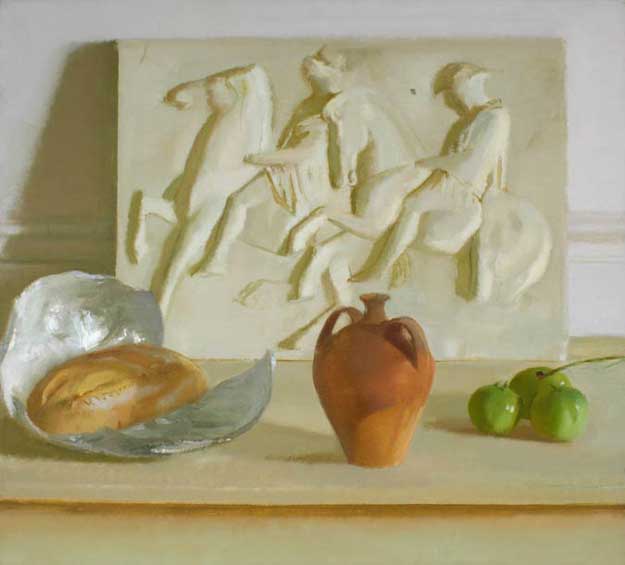
Still Life with Amphora and Bread oil on linen 32 x 36 inches 2008
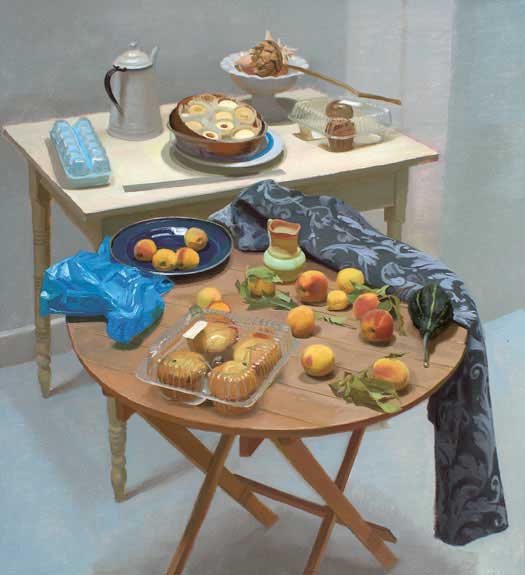
Still Life with Street Peaches oil on linen 46 x 42 inches 2008

Scott Noel painting, Photo by Mike Manley
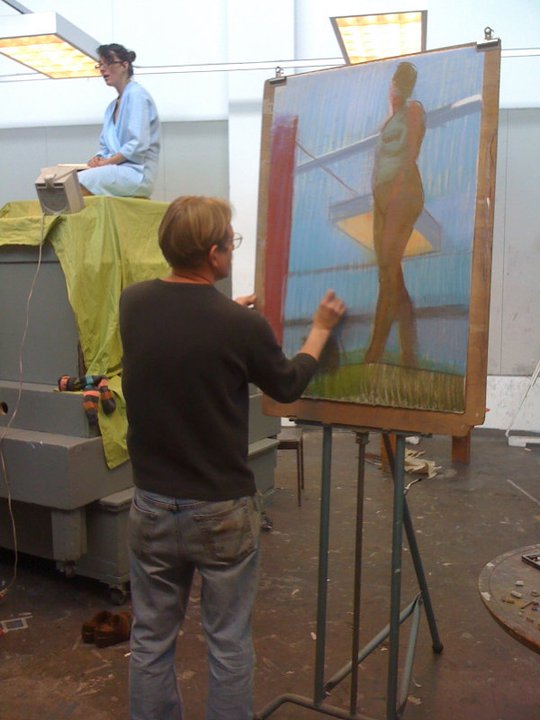
Scott Noel pastel painting, Photo by Mike Manley





Great article Elana! When I visited Scott’s studio, I had the same feeling of being refreshed and recharged with inspiration. Not only is Scott is a great professor, he is also a great companion and mentor. I’m so glad you wrote this.
I glanced at this and thought it was a photograph at first. Must be combination of always painting from life and the technique Scott uses?
I’ve heard that Scott is an inspiring teacher and artist from numerous people. Thanks for profiling his work…he has an articulate and passionate view of the world. I’d really like to see his work in person, as they seem to have a wonderful sense of light and vigorous paint handling. Oh, how I love the ‘School of Philadelphia’ artists…
Thanks for this article. I do have a question about the use of the term “Alla Prima”. Nothing about Mr. Noel’s paintings (at least the ones here) seem to me to be made in this manner. He appears, rather, to simply be a direct painter–working wet into wet at times, but also (and possibly primarily) wet over dry. Moreover, he doesn’t seem to emphasize brush work and spontaneity of color, as might an alla prima painter–instead his chief concern is subject matter and representation. I’m not implying that either one is preferable to another– just trying to clarify the use of terms. Am i way off here?
Steve, I would also agree that Scott’s painting approach doesn’t fully meet the commonly accepted definition of Alla Prima, however I would guess Elana meant more that Scott painted in the spirit of alla prima, by that I mean that by scraping down the area of the painting he was working on to almost bare canvas if the day’s painting session didn’t meet his approval – to build up the painting a section at a time, each section painted in a alla prima – “like” style. Perhaps it would have been more accurate to call it “alla primaesque”? I heard a few alla prima “purists” state that you shouldn’t even leave a ghost trace of the image behind after scraping off – that you should wipe it all off with a rag and eliminate all trace of the image – that if you don’t do this you are likely to be less open and be too protective of the drawing or hold precious previous ideas on where the painting should go. I’ve never bought into that myself but more and more I can see the logic of that. Also, building the painting up in sections and not the whole canvas during one sitting would be a big no-no I should think.
Direct painting is more accurate term.
Thanks for your response, Larry. This explanation makes a lot of sense. Even though i wouldn’t call myself an alla prima purist, I’m always skeptical when someone gives a large-scale painter that label. To my mind only a few painters (Sargent, chase, mancini etc) were able to pull off that technique in larger paintings. In any event, Mr. Noel’s work is very interesting– I especially like the way he explores mythological subject matter in a contemporary context. Thanks to you and Elana for the article!
Thanks for your comments, Charlie, Francis, and Steve!
In response to what you said, Steve, some people use “alla prima” like I think of “premier coup” which is to do the entire painting in one shot. “Alla prima,” in the context I’ve heard it used most, can also refer to a large section of a painting done directly all at one time. To my knowledge, Sargent did in fact leave a ghost image from a previous day’s work and then completely repaint on top of that.
As far as brushy paint handling, I think that it’s a personal stylistic choice on the part of any painter. Scott’s surfaces are very varied and don’t at all resemble the smooth as glass look which is the aim for many classical painters. His colors are very carefully calibrated to one another, but they are also definitely heightened when compared to looking at the motif from life.
I would definitely not say that Scott’s major concerns are subject matter and representation. They are definitely concerns of his, but just as important (if not more so) are formal concerns and most especially the experience of seeing and responding in the moment.
Now that I think about it more I think Elana’s comment is “more right” than my explanation. However, there does seem to be a fair amount of confusion of the definition…
On this site (painting.about.com) they define alla prima as:
Alla prima is a style of painting where, instead of building colors up with layers or glazing over an underpainting, the painting is completed while the paint is still wet. Strictly defined, an alla prima painting would be started and finished in one painting session, but the term is also more loosely applied to any painting done in a direct, expressive style, with minimal preparation.
Alla prima comes from Italian, literally meaning “at once”. The French term is premier coup.
However the wikipedia defines it more like what Elana wrote:
alla prima is a painting technique done mostly in oils, in which the work is completed before the first layer of painting has dried up or is still wet, such as the ‘impressionist’ technique or ‘Glaze (painting technique)’. As opposed to traditional oil painting where the artist has to wait for one layer of painting to dry before applying the next one, with the “alla prima” method, wet painting is applied over still wet painting. The primary benefit of this is the speed at which the work can be finished: hours instead of weeks. The work done using “alla prima” can be carried out in one or more sessions -depending of the type of paints used and their respective drying time- but it is mostly done in one session or “sitting” only.
The term “alla prima” is Italian for at first attempt, a way of describing the fast pace of the technique. May also be referred to as ‘wet-on-wet’, ‘direct painting’ or the French au premier coup (at first stroke).
Elena,
Thanks for the response– this is a good discussion. I regret saying he was focused on representation– because clearly his work isn’t limited an any way to that. I guess i just meant representation of an idea, if not necessarily the objects in front of him–but even that’s too limiting. Also, I’ve always wondered when artists are described as responding in the moment–because don’t all artists (or at least painters) do that? (with maybe the exception of minimalists, pop artists, hyper-realists, i.e., “production-centered” artists, if you will). in other words, for most painters, i don’t see that as a unique descriptor unless it refers to something more specific– like a one-off painting or something. Watching the video though it’s apparent that’s a huge part of his work– one to two session paintings from life. at any rate, thanks so much for this introduction to a really amazing painter..
Larry,
As to the definitions– aren’t they lacking in terms of purpose? there’s only mention of technique (wet into wet) without a discussion of the intent (as i see it) of spontaneity and immediacy. seems like that should be a component. Otherwise “alla prima” just means someone who doesn’t do an underpainting or glaze. I guess that’s fine, but then we need another word for those painters, no?
Anyway, i probably have over-commented here– so i will shut up now…
Steve, I agree that the formal definitions aren’t what’s truly important here and you are right in that the artist’s intent is. I can’t speak for Scott or other artists but I often find that really good one sitting paintings tend to be more about the visual experience of painting in front of nature – a record of what happened at that specific moment, a visual poem about what you saw and what you found to say about it. This is way different than painting to try and accurately mirror the appearance of nature.
Some painters (like Edwin Dickinson) have a body of work that are one sitting (or perhaps “cheat” and turn it into a 2 or 3 sitting painting and then a body of work that is large scale “machines” that are painted over the course of months and years. Really good painters like E.Dickinson can sustain a similar freshness and visual approach to their long term paintings as well as their short term.
Strict adherence to definitions are apt to turn into doctrine and rigidity of thought is dangerous for a painter.
I don’t think you over commented at all, thanks for your thoughtful words.
Yes, i agree completely, especially the analogy to poetry. That’s such an apt description for what I feel alla prima (or whatever the term) is… it’s poetry. Some painters “write” novels and some short stories, some are journalists and some are poets. Dickinson was certainly a master poet. I guess I’m just personally resentful of the fact that so few people outside of the painting community (and maybe even only the “perceptual painting” community) recognize his )and others’) genius… In my experience so many of my non-painting friends have somehow come to the conclusion that photo-realists are the true masters of their craft–when in reality that’s one of the easier styles to master, technically speaking. This is one area that i think definitions might help — so that it’s more clear to the general public just what a painter is attempting. I just hate that so many wonderful painters today (legitimate masters) don’t get the recognition they deserve. i know it’s not about that– but it still bothers me.
Wonderful article, Elana. Excellently articulated. You made me feel like I was back at PAFA again, hearing Scott speak so eloquently and trying to soak up every ounce of poetry and wisdom.
I wish I had taken more classes with Scott and would love to touch base with him if possible. I haven’t been able to find him on Facebook. Does anyone know if he has an online forum or somewhere that former students can drop him a line?
Thank you, Cameron! Aurelia, I will ask Scott if I can pass along his contact info and I’ll let you know. He doesn’t really have an online presence…he’s old school like that.
I love the romantic, modern, aesthetic approach to perceptual painting that Mr. Scott champions, but find his video-taped comments about what Jesus said incorrect. Jesus never said that heaven is here and now. Mr. Scott is mixing up zen philosophy with Christ’s teachings. I am as much into the flowing state of mind that painting practice elicits as any other perceptual painter, but lets get our quotes straight here. Also, I just want to point out to anyone open-minded enough to consider this, that the philosophy about perception espoused by so many “alla prima” painters these days is based in existentialism, is called phenomenology, created by Husserl and articulated further by Maurice Merleau-Ponty, and is not a religion. The ethics of Jesus’ teachings, just like the historical Buddha and every other major religion in our world, emphasize sacrifice of ones self over the kind of self-involved, individualism that underlies what I am starting to think of as the cult of perceptual painting.
I don’t know why Mr. Noel needs to preface his ideas on art with a facile account of religion. To bite back, why do all his paintings look the same if he’s so open to experience and working without premeditation or intent? I don’t buy it. Edwin Dickinson – that’s what perceptual painting without premeditation looks like.
Is there a theme of doubling in these paintings or am I imagining it? I mean symbolic elements such as the mirrors, the two women posing side by side, the idea of painting a a painting as it is being painted – I wonder what it means / if I’ve even got this right?!
Best instructor I ever had !!
The paintings I find very photographic. Why not get a camera and save the valuable time, or not spend living time, given an allotment, as we all have. I find the paintings are photographic magnificent.